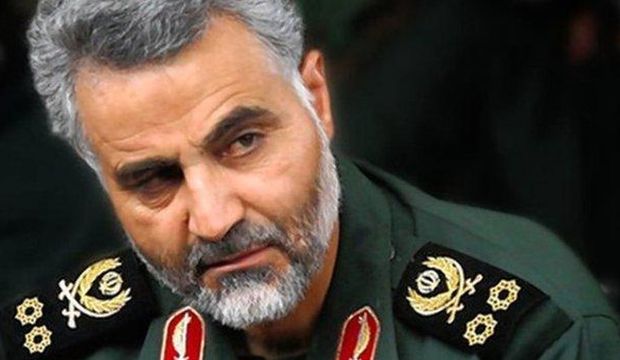Before a year ago, mystery, intrigue and frustration surrounded the search for any report, photograph, or fact relating to Qassem Suleimani, the leader of Iran’s Quds Force, a division of its Islamic Revolutionary Guards Corps. For more than two decades Suleimani’s mission has been to export the values of Khomeini’s revolution outside Iran, a difficult and major task requiring an uncomfortable blend between a religious ideology and the nasty, sometimes brutal work of a security specialist—and always, naturally for a man known to many as the “Shadow Commander,” conducted under a veil of darkness and secrecy.
But now things appear to have changed somewhat . . .
The usual amateur, low-quality images of Suleimani are no longer that rare, and neither are the videos of him appearing fleetingly at a public event or celebration in Iran. For months now, high-quality photographs and footage of Suleimani have been appearing regularly, and the image of Suleimani smiling to the camera, exaggerating a pose, or even checking on the quality of the camera being used to snap him up, has become a regular sight for those who follow the man’s movements. In those pictures he may appear with his arm around Iranian, Iraqi or Syrian soldiers who have been fighting in Iraq or Syria. Here in Beirut in January he even visited the graves of Hezbollah fighters who died in Quneitra in Syria, with the pictures and news reports all out there in the open.
Suleimani is no longer the perennially mysterious and silent “Shadow Commander” of old whose very mention could tip the scales from truth to legend. He now shouts out from the rooftops that, yes, he is Tehran’s strongman tasked with expanding its military influence outside its own borders to Syria, Iraq, Lebanon, Yemen, and Palestine. And, yes, those are photographs of him on foreign soil commanding Iranian soldiers, disregarding the sovereignty of other states. And, yes, in case you are wondering, those soldiers are ready to do everything he commands.
Such images of Suleimani are transformed when seen in the light of Tehran’s propagandist perspective, which now boasts unequivocally and unabashedly of the Islamic Republic’s foreign exploits. A template excuse for this transformation is of course ready and available: “We are fighting the Islamic State of Iraq and Syria [ISIS] and the takfirists. So these photographs and opinion pieces that sing Suleimani and his movement’s praises present him as someone capable of standing up to ISIS leader Abu Bakr Al-Baghdadi. Do you really think it is the international anti-ISIS coalition that has stopped the group’s advance?”
These are, naturally, the words of Hezbollah leader Hassan Nasrallah, taken from a recent televised interview during which he mocked the Western powers and tried to ascribe any success in holding back ISIS’s advances in Syria and Iraq to Suleimani.
So, according to the Iranian account, and those of its allies, Suleimani is the only person capable of stopping ISIS. He and his group are the only ones who can truly stand up to this barbarous plague of murderers, decapitators and takfirists.
But let us try and think for a moment; what kind of strategy would Suleimani use to defeat this bloodthirsty group?
Well, in Syria Suleimani has offered his support to the forces of Syrian President Bashar Al-Assad to fight groups such as ISIS—essentially fighting those who would cut off heads and burn people alive with those who would torture their own people and (also) burn them alive, though in this case using barrel bombs.
In Iraq, a country that represents great strategic importance for Tehran, Suleimani is fighting ISIS using militias and armed groups such as the Shi’ite Islamist Asa’ib Ahl Al-Haq and the infamous Badr Organization. How are these militias helping in the fight against extremist groups such as ISIS exactly? A slew of reports have recently flooded in—the most prominent of which was by Human Rights Watch—accusing these groups of carrying out mass killings of prisoners (including burning people alive), as well as torching homes in the Diyala region in the country, where Iranian influence is strong.
Some of Tehran’s supporters use an incredibly lame and inane question when attempting to defend the country against its detractors here: “Who would you prefer, Iran or ISIS?” (As if those were the only two choices available and we could easily just settle for anything or anyone so long as they are “not as bad as ISIS.”)
What is even more galling here is that these selfsame people will then insist that the Badr Organization or Asa’ib Ahl Al-Haq or any of these other groups Iran supports offer “less harrowing” alternatives to ISIS. Are they any less harrowing, these groups which carry out acts of mass murder and burn prisoners alive, than one whose preferred method of execution is decapitation?
The truth is that the difference between these groups vanishes as soon as you take away the camera: ISIS glorifies in wanton violence and wants you to see this; the others do it behind closed doors. As for Asa’ib Ahl Al-Haq and the Badr Organization, it is Human Rights Watch that will expose them for us. Indeed, the organization’s report on these militias is a must-read, one that fully exposes Tehran’s once-mysterious Shadow Commander, dragging him out into the light for all to see.
